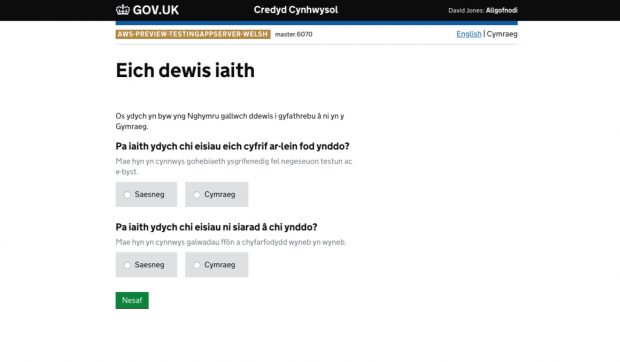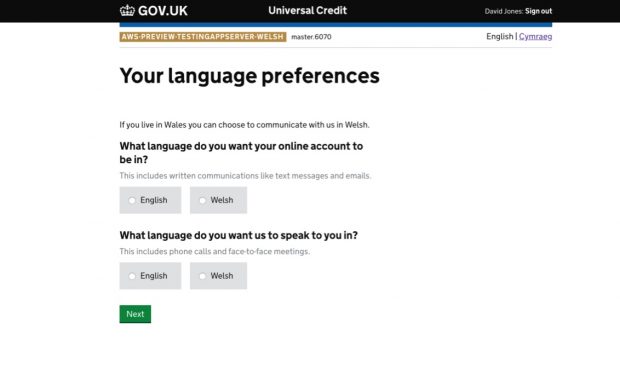
We’ve launched a Welsh-language version of the Universal Credit (Credyd Cynhwysol) online service. Here’s a brief overview of the work that’s gone into it.
Why we’ve done this
There are around half a million Welsh speakers in Wales. Under the Welsh Language Act (1993), Welsh and English have equal status in Wales. So far, the Welsh-language options for Universal Credit have been limited, as they were only intended as a temporary solution. Now, to coincide with the rollout of Universal Credit to the areas with most Welsh speakers, we’ve launched a fully Welsh version for claimants.
Getting started
We started with workshops and user research.
In our workshops we defined the scope of the project, identified the associated risks and issues, and designed new workflows to run a Welsh service.
We went to Bangor to speak to Welsh-speaking Universal Credit agents and translators. We wanted to better understand how the current system works and learn lessons to apply to the new one.
Discovering people’s needs
The research provided useful insights that helped us design the service.
For example, among Welsh speakers there is a great deal of variation in fluency, whether written or spoken. So some claimants want both spoken and written communications in Welsh, while others prefer to speak Welsh but get written communication in English. The new service allows claimants to choose the combination that suits them best.
Even if fluent, many people want the ability to easily switch between Welsh and English versions of a page so they can be confident they’ve understood it - especially where it includes technical or legal terms. We’ve included this functionality in the service.

Translating the content
To translate the existing service into Welsh, staff from our Welsh Language Unit (WLU) worked from text files extracted from the Universal Credit system containing a mix of content and code. A developer put the translated versions into a prototype Welsh service.
The WLU staff then reviewed the content as it appeared on screen. They found two issues that they’d already anticipated.
First, lots of pages in the Universal Credit service are composed of ‘snippets’ of text pulled in from different sources. This is how dynamic online services work: the composition of a page depends on the user’s action, for example how they answer questions. The Welsh-language snippets - translated in isolation - did not always make grammatical sense when combined.
Second, Welsh has no direct equivalent to ‘yes’ - the required response depends on the context of the question. Many pages in the Universal Credit service require a yes or no answer. Some of the Welsh versions needed to be amended to take account of the question context.
These issues were relatively easy to fix, but we learned the importance of reviewing every Welsh-language page on screen after the initial translation. We’ve included a quality assurance step in our new Welsh content workflow to make sure this happens.
Providing ways in
Translating the existing service is only part of the story. We also needed to consider the user experience.
We’ve created a number of routes into the Welsh service. You can access it direct from GOV.UK. You will also be offered the Welsh option if you type in a Welsh postcode when making an application. And we’ve made it easy for agents to change an existing claimant’s language preferences (whether written, spoken or both) when asked to do so.
Running the service
Launching this service is only the end of the beginning. Now we need to maintain it, which means publishing Welsh language updates at the same time as English ones.
To manage this we’ve designed a new workflow in our Jira work-management tool. Tickets created in a team’s backlog now have a field to indicate whether claimant-facing content is required as part of that work.
If it is, a linked ticket called a ‘sub-task’ is created to handle the translation into Welsh. As the sub-task is moved through the different workflow stages it’s automatically assigned to the Welsh Language Unit for action - once when the translation is required, then again when it’s ready for quality assurance.
Hopefully this will keep the two versions of the service synchronised. But in true ‘belt and braces’ style we’ve also built some fail-safes into the system. These will warn us if English-language content is added or updated without a Welsh-language equivalent.
Ymlaen (Onwards)!
Now that the Welsh-language service is live, we can start gathering data and feedback to see how it’s being used, and to understand how our new content workflow is performing. We’ll continuously review and improve it to ensure we’re providing a truly effective service for Welsh-speaking claimants.
Like this blog? Why not subscribe for more blogs like this? Sign up for email updates whenever new content is posted!
Although we usually only publish English language content on our blog, because of the subject matter of this blogpost we've included a Welsh language translation below.
Credyd Cynhwysol: Credyd Cynhwysol yn y Gymraeg

Rydym wedi lansio fersiwn Gymraeg o’r Gwasanaeth Credyd Cynhwysol (Universal Credit) ar-lein. Dyma drosolwg byr o’r gwaith sydd wedi mynd ymlaen i’w gynhyrchu.
Pam rydym wedi gwneud hyn
Mae tua hanner miliwn o siaradwyr Cymraeg yng Nghymru. O dan Ddeddf yr Iaith Gymraeg (1993), mae gan y Gymraeg a'r Saesneg statws cyfartal yng Nghymru. Hyd yn hyn, mae'r opsiynau Cymraeg ar gyfer Credyd Cynhwysol wedi bod yn gyfyngedig, gan mai eu bwriad oedd bod yn ateb dros dro. Nawr, i gyd-fynd â chyflwyno Credyd Cynhwysol i'r ardaloedd sydd â'r rhan fwyaf o siaradwyr Cymraeg, rydym wedi lansio fersiwn lawn Gymraeg ar gyfer hawlwyr.
Dechrau arni
Bu i ni ddechrau gyda gweithdai ac ymchwil defnyddwyr.
Yn ein gweithdai, gwnaethom ddiffinio cwmpas y prosiect, gan nodi'r risgiau a'r materion cysylltiedig, a dyluniwyd llif gwaith newydd i redeg gwasanaeth Cymraeg.
Fe aethom ni i Fangor i siarad ag ymgynghorwyr Credyd Cynhwysol Cymraeg a chyfieithwyr. Roeddem am ddeall yn well sut oedd y system gyfredol yn gweithio a dysgu gwersi i weithredu yn yr un newydd.
Darganfod anghenion pobl
Darparodd yr ymchwil fewnwelediadau defnyddiol a helpodd ni i ddylunio'r gwasanaeth.
Er enghraifft, ymhlith siaradwyr Cymraeg, mae llawer iawn o amrywiad o ran rhuglder, boed yn ysgrifenedig neu ar lafar. Felly mae rhai hawlwyr am gael cyfathrebu ar lafar ac ysgrifenedig yn Gymraeg, tra bod well gan eraill siarad Cymraeg ond cael cyfathrebu ysgrifenedig yn Saesneg. Mae'r gwasanaeth newydd yn caniatáu i hawlwyr ddewis y cyfuniad sy'n gweddu orau iddynt.
Hyd yn oed os yn rhugl, mae llawer o bobl eisiau’r gallu newid yn hawdd rhwng fersiynau Cymraeg a Saesneg o dudalen fel y gallant fod yn hyderus eu bod wedi’i ddeall - yn enwedig lle mae'n cynnwys termau technegol neu gyfreithiol. Rydym wedi cynnwys y gallu i wneud hyn yn y gwasanaeth.

Cyfieithu’r cynnwys
Er mwyn cyfieithu'r gwasanaeth presennol i'r Gymraeg, bu staff o'n Uned Iaith Gymraeg (yr Uned) yn gweithio o ffeiliau testun a dynnwyd o'r system Credyd Cynhwysol oedd yn cynnwys cymysgedd o destun a chod. Roedd datblygwr yn rhoi'r fersiynau a gyfieithwyd i mewn i brototeip o wasanaeth Cymraeg. Yna, adolygodd staff yr Uned y cynnwys fel ag oedd yn ymddangos ar y sgrin. Fe wnaethon ddod o hyd i ddau fater roeddent eisoes wedi eu rhagweld.
Yn gyntaf, mae llawer o dudalennau yn y gwasanaeth Credyd Cynhwysol yn cynnwys 'clipiau' o destun wedi'u tynnu i mewn o wahanol ffynonellau. Dyma sut mae gwasanaethau deinamig ar-lein yn gweithio: mae cyfansoddiad tudalen yn dibynnu ar weithrediadau defnyddiwr, er enghraifft, sut maent yn ateb cwestiynau. Nid oedd y clipiau Cymraeg - wedi'u cyfieithu ar eu pen eu hunain - bob amser yn gwneud synnwyr gramadegol pan oeddent yn cael eu cyfuno yn y gwasanaeth.
Yn ail, nid oes gan y Gymraeg gyfieithiad uniongyrchol ar gyfer ‘yes’ - mae'r ymateb gofynnol yn dibynnu ar gyd-destun y cwestiwn. Mae angen ateb ‘yes’ neu ‘no’ ar lawer o dudalennau yn y gwasanaeth Credyd Cynhywsol. Roedd angen diwygio rhai o'r fersiynau Cymraeg i ystyried cyd-destun cwestiwn.
Roedd y materion hyn yn gymharol hawdd i'w datrys, ond fe wnaethom ddysgu pwysigrwydd adolygu pob tudalen Gymraeg ar y sgrin yn dilyn y cyfieithiad cychwynnol. Rydym wedi cynnwys cam sicrwydd ansawdd yn ein llif gwaith cynnwys Cymraeg newydd i sicrhau bod hyn yn digwydd.
Darparu mynediad i’r gwasanaeth
Dim ond rhan o’r stori yw cyfieithu’r gwasanaeth presennol. Roeddem hefyd angen ystyried profiad defnyddwyr.
Rydym wedi creu nifer o lwybrau i'r gwasanaeth Cymraeg. Gallwch gael mynediad iddo yn uniongyrchol o GOV.UK. Byddwch hefyd yn cael cynnig yr opsiwn Cymraeg os byddwch yn teipio cod post sydd yng Nghymru wrth wneud cais. Ac rydym wedi ei gwneud hi'n hawdd i ymgynghorwyr newid dewisiadau iaith hawlwyr presennol (boed yn ysgrifenedig, ar lafar neu'r ddau) pan ofynnir iddynt wneud hynny.
Rhedeg y gwasanaeth
Dim ond diwedd y dechrau yw lansio'r gwasanaeth hwn. Nawr mae angen inni ei gynnal, sy'n golygu cyhoeddi diweddariadau Cymraeg ar yr un pryd â rhai Saesneg.
Er mwyn rheoli hyn, rydym wedi cynllunio llif gwaith newydd o fewn Jira, ein dull rheoli gwaith. Bellach mae gan docynnau a grëwyd o fewn llwyth gwaith tîm faes i nodi a oes angen cynnwys mae hawlwyr yn ei weld fel rhan o'r gwaith hwnnw.
Os ydyw, crëir tocyn cysylltiedig o'r enw 'is-dasg' i drefnu’r cyfieithiad i'r Gymraeg. Fel mae’r is-dasg yn symud trwy'r cyfnodau llif gwaith gwahanol, caiff ei neilltuo'n awtomatig i'r Uned Iaith Gymraeg i’w weithredu - unwaith y bydd y cyfieithiad ei angen, yna unwaith eto pan fydd yn barod i sicrhau ansawdd.
Gobeithio y bydd hyn yn cadw'r ddwy fersiwn o'r gwasanaeth yn gydamserol. Ond mewn gwir arddull 'bod yn ddiogel', rydym hefyd wedi adeiladu rhai diogelfannau i mewn i'r system. Bydd y rhain yn ein rhybuddio os yw cynnwys Saesneg yn cael ei ychwanegu neu ei ddiweddaru heb fersiwn Gymraeg cyfatebol.
Ymlaen (Y dyfodol)!
Nawr bod y gwasanaeth Cymraeg yn fyw, gallwn ddechrau casglu data ac adborth i weld sut mae'n cael ei ddefnyddio, ac i ddeall sut mae ein llif gwaith cynnwys newydd yn perfformio. Byddwn yn adolygu ac yn gwella'n barhaus i sicrhau ein bod yn darparu gwasanaeth gwirioneddol effeithiol ar gyfer hawlwyr sy'n siarad Cymraeg.

2 comments
Comment by Keith Prust posted on
This is great. It sounds like you've learnt a lot of useful things about providing a service in different languages. And well done to the Welsh Language Unit who've continued to provide their business as usual service at the same time. Dare I ask if there are plans to go a step further and publish this blog in Welsh? 🙂
Comment by John Turnbull posted on
Hi Keith, and thanks for your comment. As you can now see, we have indeed published a Welsh-language version of the post.